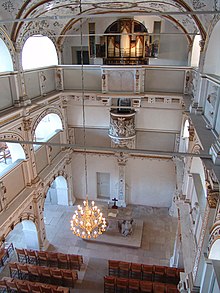Wilhelmsburg Castle (Schmalkalden)
The William Castle in the town of Schmalkalden was a secondary residence of the Landgrave of Hesse . It is one of the most important Renaissance complexes in Central Germany , which has hardly seen any structural changes to this day and has been preserved in almost its original state.
history
In 1583 the Landgraves of Hesse became the sole owners of the Schmalkalden estate, which had ruled together with the Counts of Henneberg . Wilhelm IV of Hesse immediately made the city of Schmalkalden one of his secondary residences. He had Waltaff Castle, which dates back to the 12th century, demolished and in its place the construction of the castle named after him began in 1584. On May 23, 1590 the castle church was consecrated and the castle was put into use, although the interior was not yet completely finished. The Landgrave had the mobile equipment brought in from Kassel . Wilhelm's son Moritz stayed very often and for long periods in Schmalkalden; under his client, the castle complex with farm buildings and the terrace garden was finally completed by 1618. Only temporarily used by Moritz's successors, the castle was finally completely abandoned at the beginning of the 19th century. In 1873 it was taken over by the Association for Henneberg History and Regional Studies and used as a museum. Since 1994 the complex has belonged to the Thuringian Palaces and Gardens Foundation .
investment
The castle above the city is a four-wing complex with an almost square floor plan. The extensive outdoor facilities include parade ground, gatekeeper house, pleasure garden, kitchen garden, prison tower, stables, and bakery and brewery. The room arrangement corresponds to that of a representative residential palace. The halls were equipped with roller and fittings , and they are also decorated with decorative paintings - this includes a copy of the Iwein epic by Hartmann von Aue in the basement.
The magnificent castle church, furnished by the Dutchman Willem Vernukken , is one of the most beautiful and oldest Protestant castle churches in Germany. The connection of the altar with the baptismal font, pulpit and organ in a vertical axis has been realized here for the first time and was exemplary for the conception of Protestant churches.
At the beginning of the 17th century, a terrace garden was created on the southern slope of the Schlossberg. The terrace areas, supported by sandstone walls and sloping slightly to the south, with their combination of ornamental and useful plants as well as fruit trees, served as a pleasure garden, but also to supply the court society. The central axis was emphasized by a chain of fountains decorated with sculptures. In the later 17th century, the water art was moved to the east side and flanked the newly created staircase there. From the 18th century the terraces fell into disrepair and the stairs were reshaped several times. The staircase was renovated by 2011, followed by the restoration of the basic structure of the terraces by 2015. A design drawing from 1672, which can be proven to be assigned to this area, served as a template for the ornamental planting of the upper terrace. The orchard is used to care for historical varieties.
organ
The Renaissance organ in the castle church is one of the oldest still playable instruments of this type in Central Europe. It was commissioned by Landgrave Wilhelm IV . It was created by Daniel Meyer from Göttingen. The organ gets its special timbre from 252 wooden pipes, six registers and the so-called bird's cry . The instrument was played for the first time on May 23, 1590, on the occasion of the consecration of the castle church associated with the inauguration of the castle.
|
|||||||||||||||||||||||||||
museum
In the Wilhelmsburg Castle Museum there is a permanent exhibition entitled “Dawn of a New Era” with the main themes of the Renaissance, Reformation and the Schmalkaldic League . In addition, special exhibitions are shown:
- November 2011 to March 2013: " Luther and the Witches"
- 2014: "Living and Dying in the Thirty Years War "
- 2016: "Fatal Lust - Philipp von Hessen and his double marriage"
literature
- Michael Eckardt (ed.): Paul Weber: The Wilhelmsburg over Schmalkalden . Elch-Verlag Gabriele Gorny, Bad Liebenstein 2005, ISBN 3-933566-30-4 .
- Niels Fleck, Dietger Hagner, Claudia Narr: Wilhelmsburg Castle in Schmalkalden. Official guide of the Thuringian Palaces and Gardens Foundation . 2nd, completely revised edition. Deutscher Kunstverlag, Berlin / Munich 2015, ISBN 978-3-422-03126-5 .
- The terrace garden of Wilhelmsburg Castle in Schmalkalden. History and restoration (reports from the Thuringian Palaces and Gardens Foundation , vol. 14). Michael Imhof Verlag, Petersberg 2017, ISBN 978-3-7319-0434-2 .
Web links
- Official website of Museum Schloss Wilhelmsburg
- Thuringian Palaces and Gardens Foundation, Wilhelmsburg Palace
Coordinates: 50 ° 43 ′ 23 ″ N , 10 ° 27 ′ 21 ″ E




